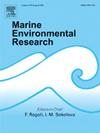Enhanced release of volatile halocarbons of microalgae in response to antibiotic-induced stress: Based on laboratory and ship-field experiments
IF 3
3区 环境科学与生态学
Q2 ENVIRONMENTAL SCIENCES
引用次数: 0
Abstract
This study investigated the impacts of sulfamethazine (SMZ) and oxytetracycline (OTC) antibiotics on the marine microalgae Nitzschia closterium and its release of volatile halocarbons (VHCs), which contribute to ozone depletion and climate change. High concentrations of SMZ and OTC suppressed cell density, reduced chlorophyll a content, and hindered Fv/Fm elevation in N. closterium, indicating its growth was inhibited. The exposure of N. closterium to antibiotics led to increased reactive oxygen species (ROS), reduced soluble protein content, and heightened catalase (CAT) activity, indicative of increased oxidative stress. This stress increased the release of three VHCs (CHBrCl2, CHBr2Cl, and CHBr3). Ship-borne experiments showed that high phytoplankton biomass was linked to high VHC release. Notably, the production and release of VHCs were significantly higher in the high-concentration antibiotic group (100 μg/L) than the low-concentration group (0.1 μg/L). These findings suggested that antibiotics induce excess ROS in algal cells, stimulating VHC production and release.
微藻类在抗生素诱导的压力下增强了挥发性卤化碳的释放:基于实验室和船田实验
本研究调查了磺胺甲基嘧啶(SMZ)和土霉素(OTC)抗生素对海洋微藻 Nitzschia closterium 及其挥发性卤代烃(VHCs)释放的影响。高浓度的 SMZ 和 OTC 抑制了 N. closterium 的细胞密度,降低了叶绿素 a 含量,阻碍了 Fv/Fm 的升高,表明其生长受到了抑制。将 N. closterium 暴露于抗生素会导致活性氧(ROS)增加、可溶性蛋白质含量降低和过氧化氢酶(CAT)活性升高,表明氧化应激增加。这种压力增加了三种 VHC(CHBrCl2、CHBr2Cl 和 CHBr3)的释放。船载实验表明,浮游植物生物量高与 VHC 释放量高有关。值得注意的是,高浓度抗生素组(100 μg/L)的 VHC 产量和释放量明显高于低浓度组(0.1 μg/L)。这些发现表明,抗生素会诱导藻细胞产生过量的 ROS,从而刺激 VHC 的产生和释放。
本文章由计算机程序翻译,如有差异,请以英文原文为准。
求助全文
约1分钟内获得全文
求助全文
来源期刊

Marine environmental research
环境科学-毒理学
CiteScore
5.90
自引率
3.00%
发文量
217
审稿时长
46 days
期刊介绍:
Marine Environmental Research publishes original research papers on chemical, physical, and biological interactions in the oceans and coastal waters. The journal serves as a forum for new information on biology, chemistry, and toxicology and syntheses that advance understanding of marine environmental processes.
Submission of multidisciplinary studies is encouraged. Studies that utilize experimental approaches to clarify the roles of anthropogenic and natural causes of changes in marine ecosystems are especially welcome, as are those studies that represent new developments of a theoretical or conceptual aspect of marine science. All papers published in this journal are reviewed by qualified peers prior to acceptance and publication. Examples of topics considered to be appropriate for the journal include, but are not limited to, the following:
– The extent, persistence, and consequences of change and the recovery from such change in natural marine systems
– The biochemical, physiological, and ecological consequences of contaminants to marine organisms and ecosystems
– The biogeochemistry of naturally occurring and anthropogenic substances
– Models that describe and predict the above processes
– Monitoring studies, to the extent that their results provide new information on functional processes
– Methodological papers describing improved quantitative techniques for the marine sciences.
 求助内容:
求助内容: 应助结果提醒方式:
应助结果提醒方式:


